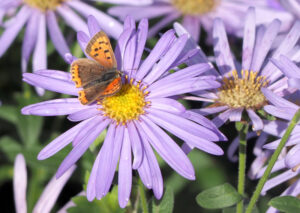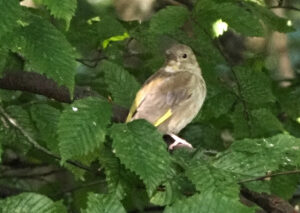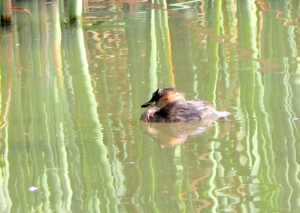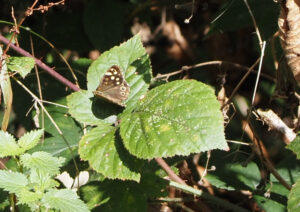Our group of 12 set off for the super Warnham Nature Reserve on a bright and warm Friday morning. We were Nige & Debbie, Janet & Steve, Lorna, Lesley, Diana, Pauline, Jane, Ian, Jill and Audrey. Having met together, Nige ramped up the pressure on everyone by setting a stiff target of 25 species of bird to be identified during the morning. We started off in one big group in the new visitor centre getting some water birds under our belt. Great Crested Grebes were ticked off along with Herring and Black Headed Gull, Moorhen and Cormorant. So far so good. The ducks tried to trick us. The Mallard were ok but a sleepy trio some way out were still wearing their rather tatty and splodgy eclipse plumage so it took us a while to realise they were Tufted Ducks. Debbie’s group moved on first as our second challenge was to try and get round the reserve in 2 clumps without meeting up with each other (and you thought these walks were stress free affairs!). We knew they had found an attractive little butterfly on the blue daisies in the gorgeous wildflower plot the reserve has created and we had the ace identifier up our sleeve – Ian. He announced we were looking at a splendid Small Copper.

As we moved on we heard Robin, Blackbird and Chiffchaff in the woods and on arriving at the first bird feeding station we watched Great and Blue Tits competing with no less than 4 Magpies for possession of the feeders. A couple of non descript birds were chilling out in a tree and turned out to be a pair from a latish Greenfinch brood.
A Nuthatch made a quick raid but was not seen again. Maybe one look at us lot was enough! Even this far from the water we were beginning to see some nice damselflies and dragonflies. These included Migrant Hawker, Red Darter and Blue Damselfly (thank you Ian). Next stop was by the lake where we were quietly enjoying the grebes and ducks when the sky erupted with 2 skeins of Canada Geese wheeling in to join the small band of Grey Lag Geese. This is always a stunning spectacle even if the geese are as common as Canadas. They certainly livened up the water.
Doing his best in a smaller pond was a large frog who we all agreed was lucky not to be living in France where his legs would possibly have made a substantial starter. Not so the froglet Lesley found for the other group which was apparently tiny. It was at this point we met a man who had seen a weasel but we felt this was a bit too tenuous to be added to our sightings list.
With no end of Great Crested Grebes popping up and down like mini submarines practicing manoeuvres  we were pleased to spy their tiny cousin the Little Grebe or Dabchick quietly minding its own business close to the reeds.
we were pleased to spy their tiny cousin the Little Grebe or Dabchick quietly minding its own business close to the reeds.
We left it to its own devices and sauntered in to the big bird feeding hide where a number of species were sporadically feeding. It was interesting to watch a rather bemused Chiffchaff coming in and out to the feeders with Blue Tits but clearly not knowing what he had to do to get food. He should have stayed with the Blackcap we had seen gorging on elderberries a little earlier. While we were doing some comfy birding in the hide Debbie’s group were venturing further along the woodland walk and finding Wrens, Dunnocks, a Goldcrest and a Treecreeper. Good work from that lot! We finished of in the last hide where often you can see Herons at their heronry. We were unlucky there but did see Little Egrets and the ever graceful Mute Swans.
We set off back to the centre for some much anticipated coffee and pastries and as we approached the buildings I was lucky enough to see a Kingfisher belt along about a foot above the water. We dashed into the hide but were unable to locate it. Happily all of Debbie’s group saw it and that was particularly great for Diana as it was her first ever and she had come hoping she would see one. Our last sighting before coffee was this lovely Speckled Wood which Ian found for us. Thanks to Ian for all the photos.

We had a good chat over coffee and congratulated ourselves on the 2 groups not seeing hide or hair of each other on the way round. Additionally, everyone was allowed to go home because we not only achieved our target but overhauled it ……. a magnificent 32 species!